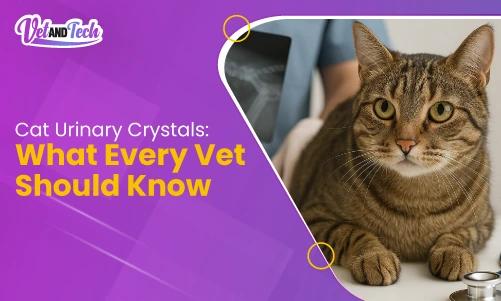How to Choose the Right Wound Dressing Types for Small Animals
Wound care in small animals is more than just applying a bandage or covering a lesion. The choice of wound dressing impacts pain intensity, infection prevention, and healing rates in animals.
For veterinarians, the knowledge to make the right decision among the different kinds of wound dressings is important in regard to patient outcomes and complication reduction.
The wrong choice can prolong healing or even make the wound more complicated. This article guides you through a step-by-step evaluation of wounds, matching dressing features, and their application in real-world cases.
UPCOMING WEBINAR: Are you excited to master the basics of veterinary bandages? Don't miss out on this webinar: "Bandaging 101: Mastering the Essentials of Veterinary Bandaging" on October 15, 2025, at 8:00 PM EST (0.5 RACE-approved CE).
Continue reading to learn about the suitable wound dressing options for small animals.
Why Does Choosing The Right Dressing Matter?
Small animal wounds tend to arrive in all sizes, from surgical cutdowns to traumatic wounds. Every wound has certain requirements for moisture equilibrium, infection control, and preservation of the skin tissue. The correct veterinary wound dressings facilitate healing, reduce complications, and improve patient comfort.
Incorrect wound dressing can cause severe complications. Bacteria may get trapped and can infect the wound site. Moreover, oxygen supply to the specific area can be affected. For that reason alone, wound dressing selection must always be intentional, based on a proper framework.
Smooth healing comes from matching the right dressing with the right wound. But to make that choice, a few key factors need to be considered first.
Factors to Consider When Choosing a Dressing
Choosing between various types of wound dressings is more than a matter of the wound. Various external and patient-related parameters influence the choice as well:
- Wound site – The injury on a paw pad might require a tough covering shield in comparison to a flank cut.
- Exudate control – Excessive drainage demands absorptive materials, such as alginate dressing, whereas wounds with moderate exudate might be better suited with a hydrocolloid dressing.
- Patient level of activity – Active dogs tend to require a safe, multilayer dog wound bandage, and cats can tolerate lightweight, less cumbersome products.
- Ease of use – Overly complicated dressings can compromise compliance when owners are managing changes at home.
- Cost and availability – The cost and availability of some veterinary wound dressings can impact decisions in clinics.
Having these considerations in mind, the next action is an organized wound evaluation.
Assess the Wound
The first step is to observe the wound site properly. A formal evaluation confirms that you know precisely what the wound needs. Try to carefully observe the depth, the quantity of exudate, and signs of infection or necrosis. Patient-specific variables such as temperament, mobility, and age also count. For example, a busy young dog might require a firmer wrap than a sedentary older cat.
This information provides a basis for choosing the appropriate dressing. With the evaluation done, the second step is to correlate the condition of the wound with suitable dressing characteristics.
Match with Dressing Properties
Different types of wound dressings are designed for different purposes. Selection is simpler once you match the wound's requirements with the properties of the material:
- Wet-to-dry dressing: Applied to wounds that need debridement. When the bandage is stripped away, debris and dead tissue are removed.
- Alginate dressing examples: Extremely absorbent, ideal for wounds with heavy exudate. They also aid in bleeding control.
- Hydrocolloid dressing: Provides a moist healing environment for shallow wounds with light to moderate exudate.
- Semi-occlusive wound dressing: Provides aeration while retaining moisture, best for surgical wounds or small lacerations.
Matching this way ensures the chosen material supports healing. Once we identify the right type, the next question is how it applies in real-world veterinary cases.
Apply The Wound Dressing Carefully
Theory has to be put into practice. For example, a cat wound bandage for a traumatic deep laceration might initially require an alginate layer to control excessive fluid, then a second protective wrap. Conversely, a small feline surgical wound can be best treated with a lightweight bandage technique using semi-occlusive materials that minimize bulk.
Chronic feline and canine wounds commonly improve with moist wound cleaning bandages to promote granulation. However, contaminated wounds can begin with wet-to-dry dressing debridement and then transition to a less aggressive approach.
Here’s a quick checklist to consider when choosing the appropriate type of wound dressing for small animals.
Practical Checklist: Choosing the Right Dressing for Small Animals
When confronted with a wound in a cat or dog, go through this rapid checklist prior to choosing a dressing:
- Wound type – Is it surgical, traumatic, chronic, or contaminated?
- Level of exudate – Dry, moderate, or heavy drainage?
- Purpose of dressing – Protection, absorption, debridement, or retention of moisture?
- Animal factors – Patient size, activity level, and temperament.
- Owner compliance – Will the owner be able to tolerate frequent changes or complicated layers?
This checklist ensures every choice is suited to the wound and the patient. It makes wound dressing types more effective in practice. Moving forward, we will discuss the change of wound dressings.
When to Change a Dressing
Selecting the right dressing is merely half the battle; prompt changes are just as crucial. A dog wound bandage that wets too readily can encourage bacteria to be trapped, whereas using a hydrocolloid dressing for too long can lead to irritation.
As a standard procedure, surgical dressings are replaced every 24–48 hours, and moisture-retentive dressings can be left on longer if exudate is kept in check. Always re-evaluate the wound at every change. When conditions change, so should the choice of dressing.
This regular review prevents unnecessary complications and maintains healing on course.
Complications To Avoid
Despite proper planning, complications are possible if dressings are used inappropriately:
- Maceration – Excessive moisture beneath the bandage can cause deterioration of nearby skin.
- Adhesive irritation – High-strength adhesives can result in redness or injury in sensitive areas.
- Infection – Occurs when dressings are not replaced properly.
- Delayed healing – Occurs when the wrong type of dressing is used for a wound.
By observing wounds carefully and changing dressings in response to evolving conditions, most of these failures can be averted.
Avoiding these complications isn’t just a theory. It’s about practice. That’s why our upcoming webinar on veterinary bandaging is designed to provide veterinary teams with practical skills they can use right away in the clinic.
Now, let’s wrap things up with the final thoughts.
Final Thoughts
Choosing the right types of wound dressings for small animals involves skill and knowledge. It needs a careful assessment of the wound, an understanding of dressing properties, and regular evaluation as healing takes place. There are various methods, from wet to dry dressings for debridement, to hydrocolloid dressings that support moist wound healing. Each material has a specific purpose when used properly.
By managing wound care with careful planning and attention, veterinary teams can lower complications, increase patient comfort, and achieve better healing results.
Eager to learn? Register now to learn step-by-step bandaging techniques, materials, and how to fix problems to improve patient care.
FAQs
How often should a wound dressing be changed in small animals?
Frequency is based on wound type, level of exudate, and dressing type. Surgical dressings, for instance, are commonly replaced every 24–48 hours, but moist wound healing bandages or hydrocolloid dressings can be used for longer.
What is the benefit of using a semi-occlusive wound dressing?
A semi-occlusive dressing permits oxygen exchange while maintaining wound moisture. This equilibrium promotes healing at a faster rate and decreases infection. It is particularly beneficial for surgical wounds or minor lacerations in small animals.
Can I use the same type of bandage for both dogs and cats?
Not always; alternatives to dog wound bandages often require more secure and stronger wraps for patients with active lifestyles. In cats, less bulky and lighter bandage options for cat wounds are ideal. Attaching a dressing to the species and activity directs compliance and improves healing









